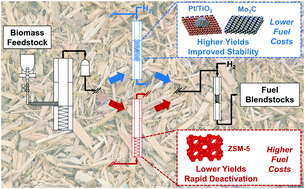Driving towards cost-competitive biofuels through catalytic fast pyrolysis by rethinking catalyst selection and reactor configuration†
Abstract
Catalytic fast pyrolysis (CFP) has emerged as an attractive process for the conversion of lignocellulosic biomass into renewable fuels and products. Considerable research and development has focused on using circulating-bed reactors with zeolite catalysts (e.g., HZSM-5) for CFP because of their propensity to form gasoline-range aromatic hydrocarbons. However, the high selectivity for aromatics comes at the expense of low carbon yield, a key economic driver for this process. In this contribution, we evaluate non-zeolite catalysts in a fixed-bed reactor configuration for an integrated CFP process to produce fuel blendstocks from lignocellulosic biomass. These experimental efforts are coupled with technoeconomic analysis (TEA) to benchmark the process and guide research and development activities to minimize costs. The results indicate that CFP bio-oil can be produced from pine with improved yield by using a bifunctional metal-acid 2 wt% Pt/TiO2 catalyst in a fixed-bed reactor operated with co-fed H2 at near atmospheric pressure, as compared to H-ZSM5 in a circulating-bed reactor. The Pt/TiO2 catalyst exhibited good stability over 13 reaction-regeneration cycles with no evidence of irreversible deactivation. The CFP bio-oil was continuously hydrotreated for 140 h time-on-stream using a single-stage system with 84 wt% of the hydrotreated product having a boiling point in the gasoline and distillate range. This integrated biomass-to-blendstock process was determined to exhibit an energy efficiency of 50% and a carbon efficiency of 38%, based on the experimental results and process modelling. TEA of the integrated process revealed a modelled minimum fuel selling price (MFSP) of $4.34 per gasoline gallon equivalent (GGE), which represents a cost reduction of $0.85 GGE−1 compared to values reported for CFP with a zeolite catalyst. TEA also indicated that catalyst cost was a significant factor influencing the MFSP, which informed additional CFP experiments in which lower-cost Mo2C and high-dispersion 0.5 wt% Pt/TiO2 catalysts were synthesized and evaluated. These materials demonstrated CFP carbon yield and oil oxygen content similar to those of the 2 wt% Pt/TiO2 catalyst, offering proof-of-concept that the lower-cost catalysts can be effective for CFP and providing a route to reduce the modelled MFSP to $3.86–3.91 GGE−1. This report links foundational science and applied engineering to demonstrate the potential of fixed-bed CFP and highlights the impact of coupled TEA to guide research activities towards cost reductions.

- This article is part of the themed collection: 2018 Energy and Environmental Science HOT Articles


 Please wait while we load your content...
Please wait while we load your content...